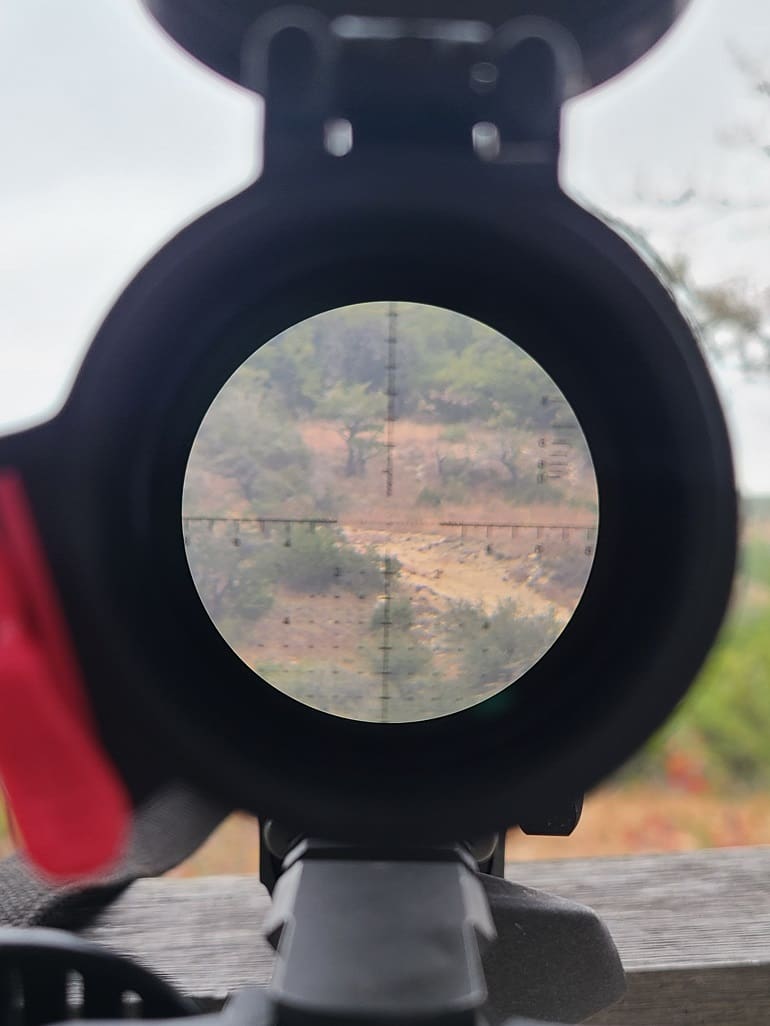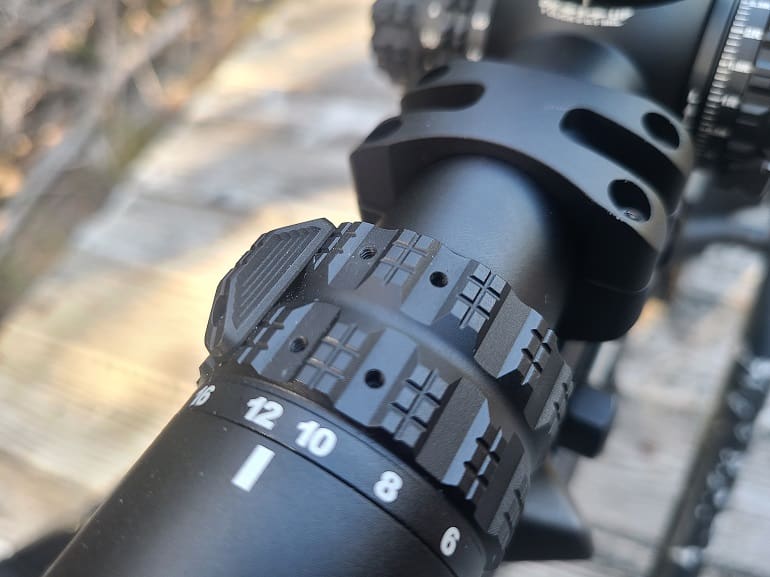Earlier this year I reviewed the Primary Arms GLx 2.5-10X44mm riflescope and announced it as the sub $1,000 optic to beat. That is still very much my rarely humble opinion. That scope is likely as much as many hunters and shooters would ever need, as would serve them very well.
But there’s a lot of people who want to push it out a little farther, who need a larger objective and substantially more magnification for precise shots. A whole lot of those same folks don’t have the money for a new Leupold Mk V HD 5-25mm scope. For them, the Primary Arms GLx 6-24×50 FFP riflescope with their Athena BPR-MIL reticle is just the thing. This scope is every bit as good as the lower power version I reviewed earlier this year, but more suited to the precision rifle shooter needing to reach out a bit further.

This is the same good glass I’ve seen in the previously reviewed scope. Take a look at the above photo. This is about as bad of a set up and conditions as you can get. Just after sunrise on a rainy morning, at 20X. The rock pile you see is about 800 yards away. The photo was taken with my camera phone held up freehand behind the glass, so there’s some focus and light lost there. You can see the clarity of the glass and the great light transmission. For this price, this Philippines made scope has some of the best glass on the market.
This scope comes with the same Athena BPR-MIL reticle I liked on their PLx series scope. I’m still shooting that one on a SCAR 20S and loving it. This is the first complex reticle I’ve found worth spending the time it takes to master.
There’s a whole lot of information provided for shooters who are willing to dedicate the time to memorizing the reticle. The center section is an open chevron. This allows the tip of the chevron to be used as a 6 o’clock hold on the target, so you get a very fine point and never obscure the target itself. To the left and right are dots and hashes, and below is the now familiar Christmas tree for holding both windage and elevation at the same time. Once memorized, this reticle allows the shooter to very quickly engage multiple targets, as well as cuts down dialing time to, well zero.
The upper left of the reticle includes a ranging ladder, common in many military themed scopes. Deployed in Afghanistan, I found these ranging ladders (mine was on the ACOG) extremely useful, but not for my own shooting. They provided close enough measurement to relay back to the belt fed guns and the Mk19 to engage quickly.
For precision shooting, they rely on knowing your target size. For target shooting, this works well, as you often know the target size. For hunting, it’s only so helpful, as game size ranges so much. For instance, White Tail deer can range from 14″ to 20″ from belly to back, depending on age, sex, and region. I have two taxidermied coyotes taken off the same land. One is 17″ from shoulder to rump, the other is 20″.
This is a First Focal Plane scope, so the reticle will size with the magnification, which allows for the same ranging techniques at any magnification. This does mean that you may have to dial back the magnifications if you need a lot of windage on small targets far away in order to see the substentions. As always, there’s a compromise for everything.

As I have done with previous Primary Arms Scopes, I checked to make sure the turrets were accurate and returned to zero. I did this through a simple box test, but also just turning both turrets all the way, each way, 10 times for each turret. I returned it to zero and then shot a round at a target 100 yards away. My round landed within an inch of the round I shot prior to moving the turrets in the first place.
Keeping the set-up simple, I left the target at 100 yards, and marked two horizontal lines 18″ apart. I aimed at the bottom one, dialed 5 mils up, and shot a round. It landed within an inch of the top line. I did this a few times each way, and then did the same with the windage. The turrets track.
They also move quite a bit. There’s 17.7 mils of elevation adjustment and 11.8 mils of windage. Assuming you are shooting standard M118LR ammo from a 20″ rifle and zeroed at 100 yards, you’ll be past 1,200 yards before you run out of elevation. And that’s in the unfortunate and unlikely case that you have a flat mount with zero angle and you aren’t using the additional 16 mils of elevation available in the reticle. Obviously, flatter shooting rounds than the old, fat, and slow .308 Winchester will have even less of an issue.
Just like the smaller GLx scopes, the 6-24X50 is packed with solid features.

The windage and elevation turrets each have a button release/lock. The turrets move well, and I would find it unlikely that they would move inadvertently, and even if so they return to zero with a zero stop. In short, the turrets release/lock buttons are nice, but unnecessary. Since they don’t require a hard push or hold that would move the glass off target during manipulation (like most pull-up models) I’m good with them.

Also, just like the previous GLx scope, the parallax knob is well done, but difficult to turn out-of-the-box. Just turn it a bunch right upon opening and the issue resolves.
You’ll also find the same great illumination controls on the left side, with the same common battery, and the “off” between each setting. The illumination does dial down enough, and the illuminated reticle is sharp enough, that it functions acceptably well at the lower magnification powers with an AN PVS 14 night vision monocular.

Positioning the monocular and mounting it in the right spot behind the glass can be a tedious procedure. The photo above is the illumination on the lowest night vision setting as seen through my monocular, inside a closet.

And just like before, the scope comes with Butler Creek lens caps right from the manufacturer. Other than a scope level and rings, the scope is great as soon as you buy it.

The magnification adjustment ring on the GLx line is unlike any other, and smarter. It moves well and stays in place, but it also has an adjustable raised portion for easier movement when you are behind the glass. This section can be moved on the ring to better suite the needs of the shooter.
One thing that surprised me was the eye relief. This is another place where budget scopes tend to go awry, but the GLx has 3.5″ at its highest magnification. Not bad at all. That makes getting behind the scope and ready to shoot fast and repeatable.
With a 50mm objective, the scope allows for a great field of view and good light. The downside is that it is not small or lightweight. At 24.5oz, it’s neither the heaviest, or the lightest in the class.
The Primary Arms GLx 6-2450mm is every bit as good as the previous GLx line I reviewed so highly. This one’s just bigger, and includes the Athena BPR-MIL reticle I liked so much on their PLx line.
Specifications: Primary Arms GLx 6-2450mm with Athena BRP-MIL
Click Value: 0.1 Mil
Exit Pupil Diameter: Low: 8.10 mm / High: 2.20 mm
Eye Relief: Low: 3.60 in / High: 3.50 in
Field View 100; Low: 15.20 ft / High: 4.20 ft
Focal Plane: First Focal Plane
Illuminated: Full Illumination
Maximum Magnification: 24
Minimum Magnification: 6
Night Vision Compatible: Yes
Objective Diameter: 50mm
Reticle: Athena BPR MIL
Reticle Type: MRAD
Total Elevation Adjustment: 17.5 MIL
Total Windage Adjustment: 11.6 MIL
Tube Diameter: 30mm
Weight: 24.5 Oz.
MSRP: $799 (actual purchase price on Primary Arms website)
Rating (out of five stars):
Overall * * * * *
Best in class by a bit. This is the second of the GLx line I’ve reviewed, and the one with the largest objective and highest magnification. It’s very surprising this level of quality is out at such a low price.









Best site very good blog primary arms scopes
I get all information from this after so many searches.
I’d be curious to see your guys opinion on some other sub $1K scopes such as Brownells MPO 3-18X and 5-25X offerings….
OK… I typed that before I found your review of the 5-25….As you were lads…..